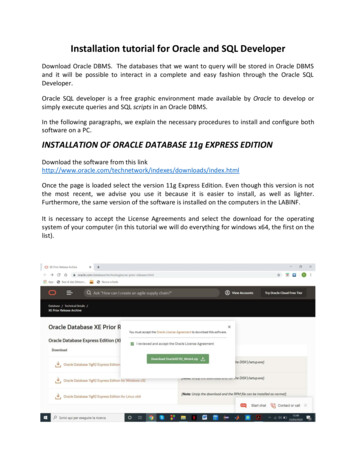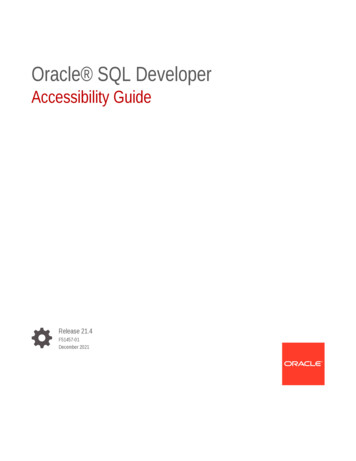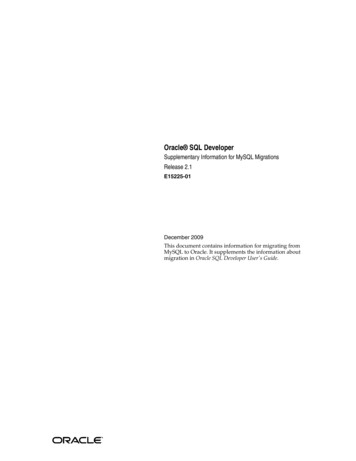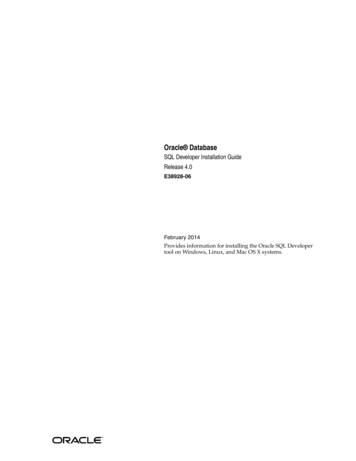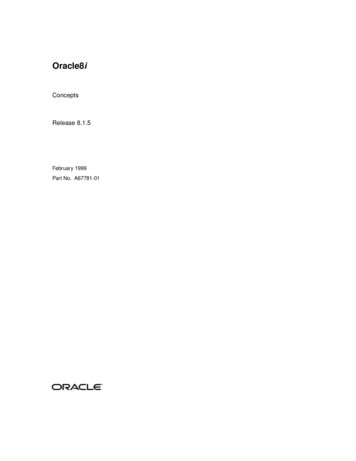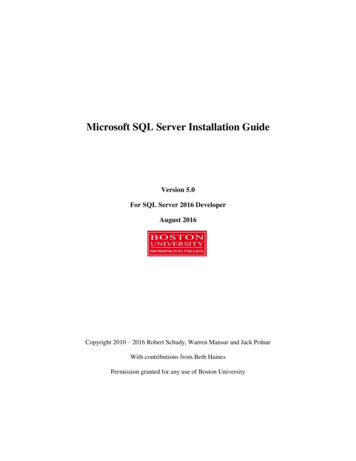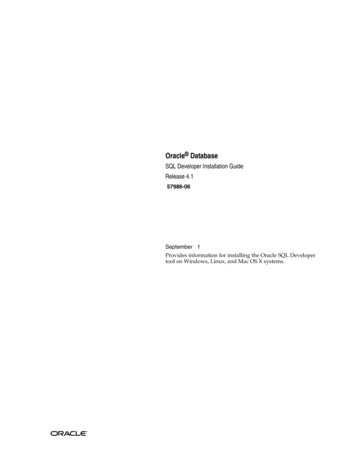
Transcription
Oracle DatabaseSQL Developer Installation GuideRelease 4.1E57986-06September 2016Provides information for installing the Oracle SQL Developertool on Windows, Linux, and Mac OS X systems.
Oracle Database SQL Developer Installation Guide, Release 4.1E57986-06Copyright 2005, 2016, Oracle and/or its affiliates. All rights reserved.Primary Author:Contributors:Chuck MurrayAshley Chen, Barry McGillin, Kris Rice, Jeff SmithThis software and related documentation are provided under a license agreement containing restrictions onuse and disclosure and are protected by intellectual property laws. Except as expressly permitted in yourlicense agreement or allowed by law, you may not use, copy, reproduce, translate, broadcast, modify, license,transmit, distribute, exhibit, perform, publish, or display any part, in any form, or by any means. Reverseengineering, disassembly, or decompilation of this software, unless required by law for interoperability, isprohibited.The information contained herein is subject to change without notice and is not warranted to be error-free. Ifyou find any errors, please report them to us in writing.If this is software or related documentation that is delivered to the U.S. Government or anyone licensing it onbehalf of the U.S. Government, the following notice is applicable:U.S. GOVERNMENT END USERS: Oracle programs, including any operating system, integrated software,any programs installed on the hardware, and/or documentation, delivered to U.S. Government end users are"commercial computer software" pursuant to the applicable Federal Acquisition Regulation and agencyspecific supplemental regulations. As such, use, duplication, disclosure, modification, and adaptation of theprograms, including any operating system, integrated software, any programs installed on the hardware,and/or documentation, shall be subject to license terms and license restrictions applicable to the programs.No other rights are granted to the U.S. Government.This software or hardware is developed for general use in a variety of information management applications.It is not developed or intended for use in any inherently dangerous applications, including applications thatmay create a risk of personal injury. If you use this software or hardware in dangerous applications, then youshall be responsible to take all appropriate fail-safe, backup, redundancy, and other measures to ensure itssafe use. Oracle Corporation and its affiliates disclaim any liability for any damages caused by use of thissoftware or hardware in dangerous applications.Oracle and Java are registered trademarks of Oracle and/or its affiliates. Other names may be trademarks oftheir respective owners.Intel and Intel Xeon are trademarks or registered trademarks of Intel Corporation. All SPARC trademarks areused under license and are trademarks or registered trademarks of SPARC International, Inc. AMD, Opteron,the AMD logo, and the AMD Opteron logo are trademarks or registered trademarks of Advanced MicroDevices. UNIX is a registered trademark of The Open Group.This software or hardware and documentation may provide access to or information about content, products,and services from third parties. Oracle Corporation and its affiliates are not responsible for and expresslydisclaim all warranties of any kind with respect to third-party content, products, and services unlessotherwise set forth in an applicable agreement between you and Oracle. Oracle Corporation and its affiliateswill not be responsible for any loss, costs, or damages incurred due to your access to or use of third-partycontent, products, or services, except as set forth in an applicable agreement between you and Oracle.
ContentsPreface . vii1Audience .viiDocumentation Accessibility .viiRelated Documents.viiConventions.viiInstalling Oracle SQL Developer1.11.2SQL Developer System Recommendations .1-1Installing and Starting SQL Developer.1-31.2.1Windows Systems .1-41.2.2Linux and Mac OS X Systems.1-51.3Migrating User Settings from a Previous Release.1-61.4Migrating Information from Previous Releases .1-71.5Location of User-Related Information .1-71.6Database Certification for SQL Developer (Oracle and Third-Party) .1-81.7Advanced Security for JDBC Connection to the Database .1-91.8Finding SQL Developer Accessibility Information. 1-101.9Using a Screen Reader and Java Access Bridge with SQL Developer . 1-101.9.1If You Need to Install Java Access Bridge. 1-111.10Uninstalling SQL Developer . 1-121.11SQL Developer Documentation. 1-121.12Oracle on the Web. 1-12iii
iv
List of Tables1-11-21-31-41-51-6Recommendations for Windows Systems.Recommendations for Linux Systems.Recommendations for Mac OS X Systems.Default Locations for User-Related Information.Oracle Database Certification for SQL Developer.Non-Oracle (Third-Party) Database Certification for SQL Developer.1-21-21-21-71-81-9v
vi
PrefaceThis guide provides information for those installing the Oracle SQL Developer tool onWindows, Linux, and Mac OS X systems.AudienceThis guide is intended for those who need to install the Oracle SQL Developer tool.Documentation AccessibilityFor information about Oracle's commitment to accessibility, visit the OracleAccessibility Program website at http://www.oracle.com/pls/topic/lookup?ctx acc&id docacc.Access to Oracle SupportOracle customers that have purchased support have access to electronic supportthrough My Oracle Support. For information, visit http://www.oracle.com/pls/topic/lookup?ctx acc&id info or visit http://www.oracle.com/pls/topic/lookup?ctx acc&id trs if you are hearing impaired.Related DocumentsFor conceptual, usage, and reference information about Oracle SQL Developer, see theonline help available when you are running SQL Developer.To download free release notes, installation documentation, white papers, or othercollateral, go to the Oracle Technology Network (OTN) athttp://www.oracle.com/technetwork/The documentation section of the OTN website is located ntation/ConventionsThe following text conventions are used in this document:ConventionMeaningboldfaceBoldface type indicates graphical user interface elements associatedwith an action, or terms defined in text or the glossary.vii
viiiConventionMeaningitalicItalic type indicates book titles, emphasis, or placeholder variables forwhich you supply particular values.monospaceMonospace type indicates commands within a paragraph, URLs, codein examples, text that appears on the screen, or text that you enter.
1Installing Oracle SQL DeveloperNote:This guide assumes that you plan to download the SQL Developer kit file andinstall it as a freestanding tool.If you plan to use SQL Developer as part of an Oracle Database releaseinstallation, see the Oracle Database installation documentation.Please read the information in this chapter before you install Oracle SQL Developer.This chapter contains the following major sections: SQL Developer System Recommendations (page 1-1) Installing and Starting SQL Developer (page 1-3) Migrating User Settings from a Previous Release (page 1-6) Migrating Information from Previous Releases (page 1-7) Location of User-Related Information (page 1-7) Database Certification for SQL Developer (Oracle and Third-Party) (page 1-8) Advanced Security for JDBC Connection to the Database (page 1-9) Finding SQL Developer Accessibility Information (page 1-10) Using a Screen Reader and Java Access Bridge with SQL Developer (page 1-10) Uninstalling SQL Developer (page 1-12) SQL Developer Documentation (page 1-12) Oracle on the Web (page 1-12)1.1 SQL Developer System RecommendationsThis section describes the recommended minimum values for CPU, memory, display,disk storage, and other resources on the supported systems.Installing Oracle SQL Developer 1-1
SQL Developer System RecommendationsNote:SQL Developer requires JDK 8 or later, and Oracle recommends that you usethe latest available JDK, which you can download /downloads/index.htmlTable 1-1Recommendations for Windows SystemsResourceRecommended Minimum ValueOperating SystemWindows 2003 R2Windows Server 2008Windows 7Windows 8CPU Type and SpeedPentium IV 2 GHz MHz or fasterMemory2 GB RAMDisplay65536 colors, set to at least 1024 X 768 resolutionHard Drive Space42 MB if you already have JDK 8 or later110 MB if you do not have JDK 8 or laterJava SDKTable 1-2JDK 8 or later for Windows, available at: loads/index.html.Recommendations for Linux SystemsResourceRecommended Minimum ValueOperating SystemRed Hat Enterprise Linux 3.0Fedora Core 4CPU Type and SpeedPentium IV 2 GHz or fasterMemory2 GB RAMDisplay65536 colors, set to at least 1024 X 768 resolutionHard Drive Space110 MBJava SDKJDK 8 or later for Linux, available at: loads/index.htmlTable 1-3Recommendations for Mac OS X SystemsResourceRecommended Minimum ValueOperating SystemApple Mac OS X Version 10.4.xCPU Type and SpeedDual 1.25 GHz G4/G5 (1 GHz G4 minimum)Memory2 GB RAM1-2 SQL Developer Installation Guide
Installing and Starting SQL DeveloperTable 1-3(Cont.) Recommendations for Mac OS X SystemsResourceRecommended Minimum ValueDisplay"Thousands" of colorsHard Drive Space110 MBJava SDKJDK 8 or later1.2 Installing and Starting SQL DeveloperThis section contains subsections with instructions for installing SQL Developer on allsupported systems.SQL Developer does not require an installer. To install SQL Developer, you will needan unzip tool. You can download a free, cross-platform unzip tool, Info-Zip, availableat http://www.info-zip.org/.Note:Do not install SQL Developer into any existing ORACLE HOME. You will not beable to uninstall it using Oracle Universal Installer.Also, do not install SQL Developer into an existing sqldeveloper folder ordirectory. Either delete the existing sqldeveloper folder or directory first, orensure that the new SQL Developer version is installed into a differentlocation.Note:If you are using a prerelease (Early Adopter) version of SQL Developer, and ifyou want to be able to continue to use this prerelease version after installingthe official release kit, you must unzip the official release kit into a differentdirectory than the one used for the prerelease version.If Oracle Database (Release 11 or later) is also installed, a version of SQL Developeris also included and is accessible through the menu system under Oracle. This versionof SQL Developer is separate from any SQL Developer kit that you download andunzip on your own, so do not confuse the two, and do not unzip a kit over the SQLDeveloper files that are included with Oracle Database. Suggestion: Create a shortcutfor the SQL Developer executable file that you install, and always use it to start SQLDeveloper.Before you install SQL Developer, look at the remaining sections of this guide to see ifyou need to know or do anything else first.The steps for installing SQL Developer depend on whether or not you will be using iton a Windows system that does not have Java SDK (JDK) release 7 or later installed: For a Windows system with JDK release 7 or later installed, follow the instructionsin Windows Systems (page 1-4).Installing Oracle SQL Developer 1-3
Installing and Starting SQL Developer For all other systems (Linux and Mac OS X systems, and Windows systems with noJDK release 7 or later installed), follow the instructions in Linux and Mac OS XSystems (page 1-5).1.2.1 Windows SystemsIf a Windows 64-bit SQL Developer kit that includes JDK 8 is available, you candownload and install that on a Windows 64-bit system, and SQL Developer will usethe embedded JDK that is provided with that kit.However, if you need or simply want to use a JDK on your Windows 64-bit system,you can install the JDK (if it is not already installed) and the Windows 32/64-bit SQLDeveloper kit, and SQL Developer will use the JDK that is installed on your system.Note:Do not install SQL Developer into an existing sqldeveloper folder. Eitherdelete the existing sqldeveloper folder first, or ensure that the new SQLDeveloper version is installed into a different location.To install on a Windows system, follow these steps:1.Go to the Oracle Technology Network page for SQL Developer at sql-developer/Note:If a Windows 64-bit SQL Developer kit that includes JDK 8 is available, youcan download and install that on a Windows 64-bit system, and SQLDeveloper will use the embedded JDK that is provided with that kit.However, if you need or simply want to use a JDK on your Windows 64-bitsystem, you can install the JDK (if it is not already installed) and the Windows32/64-bit SQL Developer kit, and SQL Developer will use the JDK that isinstalled on your system.2.If you do not need or want to install a suitable Java Development Kit (JDK 8 orlater), go to step 3. Otherwise, download and install the JDK as follows:a.On the SQL Developer Downloads page /sql-developer/downloads/index.html), click the Download link next to SQL Developer requires JDK8 or above.b.On the Java SE Development Kit 7 Downloads page, in the table of Java SEDevelopment Kits, accept the Oracle Binary Code License Agreement for JavaSE.c.Click the link for the download that you need (for example, the Windows x64link for a Windows 64-bit system).d.Save the file anywhere on your system (such as a "temp" folder).e.Install the JDK (for example, on Windows, double-click the .exe file name andfollow the displayed instructions).1-4 SQL Developer Installation Guide
Installing and Starting SQL Developer3.On the Oracle Technology Network page for SQL Developer at sql-developer/,click the Downloads tab (next to Overview).4.Read and accept the license agreement.5.Follow the instructions for downloading and installing SQL Developer.The installation itself is simple. For example, on a Windows PC you can unzip thedownloaded file into C:\, which will create C:\sqldeveloper with files and foldersin and under it.To start SQL Developer, go to the sqldeveloper directory under the SQL Developerinstallation directory (for example, on a Windows system this might be C:\sqldeveloper), and do one of the following: On Linux systems, type: sh sqldeveloper.sh On Windows systems, double-click sqldeveloper.exe.If you are asked to enter the full pathname for the JDK, click Browse and find it. Forexample, on a Windows system the path might have a name similar to C:\ProgramFiles\Java\jdk1.7.0 51.1.Unzip the SQL Developer kit into a folder (directory) of your choice, which will bereferred to as sqldeveloper install . Ensure that the Use folder namesoption is checked when unzipping the kit.Unzipping the SQL Developer kit causes a folder named sqldeveloper to becreated under the sqldeveloper install folder. For example, if you unzipthe kit into C:\, the folder C:\sqldeveloper is created, along with severalsubfolders under it.2.To start SQL Developer, go to sqldeveloper install \sqldeveloper,and double-click sqldeveloper.exe.If you are asked to enter the full pathname for the JDK, click Browse and find java.exe.For example, the path might have a name similar to C:\Program Files\Java\jdk1.7.0 51.After SQL Developer starts, you can connect to any database by right-clicking theConnections node in the Connections Navigator and selecting New Connection.Alternatively, if you have any exported connections (see Migrating Information fromPrevious Releases (page 1-7) or Uninstalling SQL Developer (page 1-12)), you canimport these connections and use them.You can learn about SQL Developer by clicking Help, then Table of Contents, andreading the help topics under SQL Developer Concepts and Usage.1.2.2 Linux and Mac OS X SystemsSQL Developer requires that JDK 8 or later be installed on the system, and Oraclerecommends that you install the latest available JDK version. If you need to install aJDK, go to loads/jdk7-downloads-1880260.html.Installing Oracle SQL Developer 1-5
Migrating User Settings from a Previous ReleaseNote:Do not install SQL Developer into an existing sqldeveloper directory.Either delete the existing sqldeveloper directory first, or ensure that thenew SQL Developer version is installed into a different location.Note:On Macintosh systems, a native Macintosh application in the formsqldeveloperxxx.tar.gz is provided. When it is expanded, it appears asa Macintosh application that can be put into the applications folder. If youchoose to expand this file, it will replace any older sqldeveloperapplications in that folder.To install and start SQL Developer, follow these steps:1.Unzip the SQL Developer kit into a directory (folder) of your choice. (Ensure thatthe Use folder names option is checked when unzipping the kit.) This directorylocation will be referred to as sqldeveloper install .Unzipping the SQL Developer kit causes a directory named sqldeveloper to becreated under the sqldeveloper install directory. It also causes manyfiles and directories to be placed in and under that directory.2.To start SQL Developer, go to the sqldeveloper directory under the sqldeveloper install directory, and run sh sqldeveloper.sh.After SQL Developer starts, you can connect to any database by right-clicking theConnections node in the Connections Navigator and selecting New Connection.Alternatively, if you have any exported connections (see Migrating Information fromPrevious Releases (page 1-7) or Uninstalling SQL Developer (page 1-12)), you canimport these connections and use them.You can learn about SQL Developer by clicking Help, then Table of Contents, andreading the help topics under SQL Developer Concepts and Usage.1.3 Migrating User Settings from a Previous ReleaseThe first time you start SQL Developer after installing it or after adding anyextensions, you are asked if you want to migrate your user settings from a previousrelease. (This occurs regardless of whether there was a previous release on yoursystem.)These settings refer to database connections, reports, and certain SQL Developer userpreferences that you set in a previous version by clicking Tools and then Preferences.However, some user preferences are not saved, and you must respecify these using thenew release.To migrate user settings from a previous SQL Developer release:1. Unzip the kit for the current release so as to create a new sqldeveloperdirectory.2. When you start the SQL Developer current release, click Yes when asked if youwant to migrate settings from a previous release.1-6 SQL Developer Installation Guide
Migrating Information from Previous Releases3. In the dialog box that is displayed, you can accept the default option to migrate thesettings from the most recent SQL Developer installation. Or, if you want tomigrate the settings from an earlier installation, you can click to show all buildsand then select the desired one.See also Migrating Information from Previous Releases (page 1-7).1.4 Migrating Information from Previous ReleasesIf you have used a previous release of SQL Developer, you may want to preservedatabase connections that you have been using. To preserve database connections,save your existing database connections in an XML file. To save the connections, rightclick the Connections node in the Connections Navigator and select ExportConnections. After you complete the installation described in this guide, you can usethose connections by right-clicking the Connections node in the ConnectionsNavigator and selecting Import ConnectionsIf you want to use any user-defined reports or the SQL history from a previousversion, see Location of User-Related Information (page 1-7) for information aboutwhere these are located. If you have user-defined reports and SQL history fromRelease 1.0, they are modified by any later SQL Developer release to a format that isdifferent from and incompatible with Release 1.0.SQL Developer preferences (specified by clicking Tools and then Preferences) from aprerelease version of the current release cannot currently be saved and reused; youmust respecify any desired preferences.Note:If you want to uninstall your prerelease version of SQL Developer beforeinstalling this release, see Uninstalling SQL Developer (page 1-12).1.5 Location of User-Related InformationSQL Developer stores user-related information in several places, with the specificlocation depending on the operating system and certain environment specifications.User-related information includes user-defined reports, user-defined snippets, SQLWorksheet history, code templates, and SQL Developer user preferences. In mostcases, your user-related information is stored outside the SQL Developer installationdirectory hierarchy, so that it is preserved if you delete that directory and install a newversion.The user-related information is stored in or under the IDE USER DIR environmentvariable location, if defined; otherwise as indicated in Table 1-4 (page 1-7), whichshows the typical default locations (under a directory or in a file) for specific types ofresources on different operating systems. (Note the period in the name of anydirectory named .sqldeveloper.)Table 1-4Default Locations for User-Related InformationResource TypeSystem (Windows, Linux, or Mac OS X)User-definedreportsWindows: C:\Documents and Settings\ user-name \Application Data\SQL Developer\UserReports.xmlLinux or Mac OS X: /.sqldeveloper/UserReports.xmlInstalling Oracle SQL Developer 1-7
Database Certification for SQL Developer (Oracle and Third-Party)Table 1-4(Cont.) Default Locations for User-Related InformationResource TypeSystem (Windows, Linux, or Mac OS X)User-definedsnippetsWindows: C:\Documents and Settings\ user-name \Application Data\SQL Developer\UserSnippets.xmlLinux: /.sqldeveloper/UserSnippets.xmlMac OS X: /Users/ Your user /Library/Application Support/SQLDeveloper/UserSnippets.xmlSQL historyWindows: C:\Documents and Settings\ user-name \Application Data\SQL Developer\SqlHistory.xmlLinux: /.sqldeveloper/SqlHistory.xmlMac OS X: /Users/ Your user /Library/Application Support/SQLDeveloper/ SqlHistory.xmlCode templatesWindows: C:\Documents and Settings\ user-name \Application Data\SQL Developer\ CodeTemplate.xmlLinux: /.sqldeveloper/CodeTemplate.xmlMac OS X: /Users/ Your user /Library/Application Support/SQLDeveloper/ CodeTemplate.xmlSQL DeveloperuserpreferencesWindows: C:\Documents and Settings\ user-name \Application Data\SQL Developer\systemn.n.n.n.nLinux or Mac OS X: /.sqldeveloper/systemn.n.n.n.nIf you want to prevent other users from accessing your user-specific SQL Developerinformation, you must ensure that the appropriate permissions are set on the directorywhere that information is stored or on a directory above it in the path hierarchy. Forexample, on a Windows system you may want to ensure that the SQL Developerfolder and the \ user-name \Application Data\SQL Developer folder underDocuments and Settings are not sharable; and on a Linux or Mac OS X systemyou may want to ensure that the /.sqldeveloper directory is not world-readable.1.6 Database Certification for SQL Developer (Oracle and Third-Party)This section describes Oracle and non-Oracle (third-party) databases that are certifiedfor use with SQL Developer.Table 1-5 (page 1-8) lists the Oracle database certifications.Table 1-5Oracle Database Certification for SQL DeveloperProductReleasesOracle DatabaseOracle10gOracle11gOracle12cOracle Database Express EditionRelease 11.2SQL Developer can be used to view metadata and data of several non-Oracle (thirdparty) databases. Table 1-6 (page 1-9) lists the third-party database certifications.1-8 SQL Developer Installation Guide
Advanced Security for JDBC Connection to the DatabaseTable 1-6Non-Oracle (Third-Party) Database Certification for SQL DeveloperDatabaseReleasesNotesIBM DB2DB2 UDBFor any DB2 release: db2jcc.jar and db2jcc license cu.jarfiles required; available from IBM.DB2 7.xDB2 8.xDB2 9.xMicrosoft SQLServerSQL Server 7SQL Server 2000SQL Server 2005SQL Server 2008MySQLMySQL 3.xMySQL 4.xMySQL 5.xSybaseAdaptive ServerSybase 12TeradataTeradata 12Sybase 15Teradata 13For any Microsoft SQL Server release: JDBC driverjtds-1.2.jar required; included in jtds-1.2-dist.zipavailable from sourceforge.net; also available throughHelp, Check for Updates.For any MySQL release: JDBC driver required. ForMySQL 5.x: mysql-connector-java-5.0.4-bin.jar, which isincluded in mysql-connector-java-5.0.4.zip; alsoavailable through Help, Check for Updates. (Do not usethe latest MySQL driver 5.1.)For any Sybase Adaptive Server release: JDBC driverjtds-1.2.jar required; included in jtds-1.2-dist.zipavailable from sourceforge.net; also available throughHelp, Check for Updates.JDBC driver files tdgssconfig.jar and terajdbc4.jarrequired; included (along with a readme.txt file) in theTeraJDBC indep indep.12.00.00.110.zip orTeraJDBC indep indep.12.00.00.110.tar download.Note:If you need to use SQL Developer to migrate a Microsoft Access database. usethe previous version of SQL Developer (4.0.3) and the 32-bit version of theJava 7 JDK.For information about creating and using connections to third-party databases, see theinformation about database connections in the SQL Developer online help or OracleSQL Developer User's Guide.1.7 Advanced Security for JDBC Connection to the DatabaseYou are encouraged to use Oracle Advanced Security to secure a JDBC connection tothe database. Both the JDBC OCI and the JDBC Thin drivers support at least some ofthe Oracle Advanced Security features. If you are using the OCI driver, you can setrelevant parameters in the same way that you would in any Oracle client setting. TheJDBC Thin driver supports the Oracle Advanced Security features through a set ofJava classes included with the JDBC classes in a Java Archive (JAR) file and supportssecurity parameter settings through Java properties objects.For more information about using Oracle Advanced Security, see Oracle Database JDBCDeveloper's Guide.Installing Oracle SQL Developer 1-9
Finding SQL Developer Accessibility Information1.8 Finding SQL Developer Accessibility InformationFor the latest configuration information or for information on addressing accessibilityand assistive technology issues, see the Oracle Accessibility FAQ at aqs/.Also, check the SQL Developer release notes (readme.txt file) to see if there are anycurrently known issues regarding accessibility.1.9 Using a Screen Reader and Java Access Bridge with SQL DeveloperNote:Unless otherwise indicated, the information is this section also applies to DataModeler and Data Miner.To make the best use of our accessibility features, Oracle Corporation recommends thefollowing minimum configuration: Windows XP, Windows Vista Java 7 Update 6Java 7 Update 6 includes the Java Access Bridge. For more information, includinghow to enable the Java Access Bridge, see: ava se 7 update 6However, if you are using Java J2SE 1.6.0 24 or higher but before Java 7 Update 6,you must manually install Java Access Bridge 2.0.2 after you install the screenreader (if it is not already installed). Download Java Access Bridge for Windowsversion 2.0.2. The file you will download is accessbridge-2 0 2-fcs-binb06.zip. It is available from: /index-jsp-136191.html (Refer to the Java Access Bridgedocumentation avai
Database Certification for SQL Developer (Oracle and Third-Party) (page 1-8) Advanced Security for JDBC Connection to the Database (page 1-9) Finding SQL Developer Accessibility Information (page 1-10) Using a Screen Reader and Java Access Bridge with SQL Developer (page 1-10)

